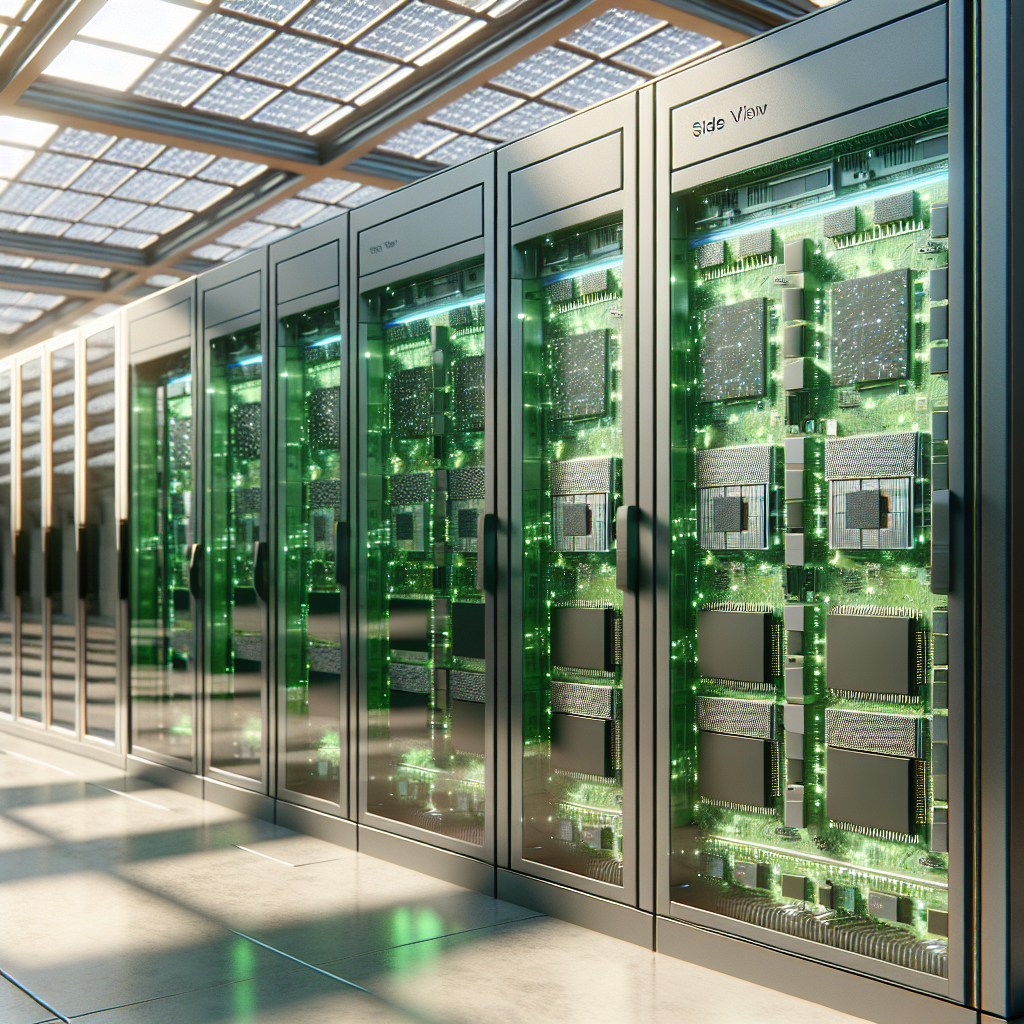The Role of AI in Energy Storage
Artificial Intelligence (AI) is increasingly becoming a pivotal component in the realm of energy storage, offering innovative solutions that enhance the efficiency and reliability of renewable energy systems. By leveraging advanced algorithms, AI can analyze vast datasets to improve the performance and lifespan of batteries, which are critical for sustainable energy storage. This optimization process involves predicting energy demand patterns, managing charge cycles, and minimizing energy wastage. The integration of AI technologies in energy storage systems not only enhances their operational efficiency but also reduces costs, making renewable energy sources more viable and accessible.
One of the primary applications of AI in energy storage is in the optimization of smart grid management. Smart grids are essential for the efficient distribution of energy, and AI can play a crucial role in their operation by processing real-time data to forecast energy usage and adjust supply accordingly. This capability ensures that energy is distributed where it is needed most, reducing the reliance on fossil fuels and lowering carbon emissions. Furthermore, AI-driven solutions can identify potential faults within the grid, allowing for proactive maintenance and minimizing downtime, which is crucial for maintaining a stable energy supply.
AI also contributes significantly to mitigating the climate impact associated with energy storage. By enhancing the efficiency of battery systems, AI reduces the need for frequent battery replacements, thereby decreasing the environmental footprint of battery production and disposal. AI systems can also facilitate the integration of various renewable energy sources, such as solar and wind, by predicting their output and aligning it with demand. This harmonization leads to a more balanced and sustainable energy ecosystem.
| AI Application | Benefits |
|---|---|
| Battery Efficiency Optimization | Increased lifespan, cost reduction, waste minimization |
| Smart Grid Management | Real-time data processing, energy demand forecasting, fault detection |
| Climate Impact Mitigation | Reduced environmental footprint, improved integration of renewables |
Understanding Sustainable Energy Systems
Sustainable energy systems are designed to meet the world’s energy demands without compromising the ability of future generations to meet their own needs. These systems primarily focus on harnessing renewable energy sources like solar, wind, and hydroelectric power. They are pivotal in reducing greenhouse gas emissions and minimizing the ecological footprint of energy production. The integration of sustainable energy systems is complex and requires a holistic approach to ensure efficiency and reliability.
One of the key components of sustainable energy systems is energy storage. Efficient storage solutions ensure that the energy generated from renewable sources can be stored and used when needed, thereby balancing supply and demand. Battery technology plays a crucial role in this process. Advanced battery systems, such as lithium-ion and solid-state batteries, offer higher energy densities, longer life cycles, and reduced environmental impact. These technologies are continuously evolving, driven by the need for more sustainable and cost-effective solutions.
Moreover, the integration of smart grid technologies enhances the management and distribution of renewable energy. Smart grids utilize digital technology to monitor and manage the transport of electricity from all generation sources to meet the varying electricity demands of end consumers. This dynamic system allows for real-time data collection and analysis, optimizing energy flow and improving the resilience of the energy infrastructure. The following table illustrates some key benefits of smart grids:
| Benefit | Description |
|---|---|
| Improved Efficiency | Reduces energy losses during transmission and distribution. |
| Enhanced Reliability | Quickly detects and responds to outages, maintaining a stable supply. |
| Increased Integration | Facilitates the incorporation of renewable energy sources into the grid. |
As we advance towards a renewable future, understanding and improving sustainable energy systems becomes increasingly vital. The adoption of AI-driven solutions is pivotal in this transformation, offering the potential to optimize every aspect of energy storage and distribution. By leveraging AI technologies, we can enhance battery performance, streamline grid management, and significantly reduce the overall carbon footprint of energy systems.
AI Algorithms Optimizing Battery Efficiency
The integration of AI algorithms in energy storage systems is transforming the efficiency of batteries, which are crucial for sustainable energy solutions. AI-driven technologies analyze vast amounts of data to predict battery life cycles, enhance charging protocols, and prevent potential failures. By utilizing machine learning models, these algorithms can adapt to different battery chemistries and usage patterns, ensuring optimal performance and longevity.
One of the significant advantages of AI in battery management is its ability to create predictive models that anticipate battery degradation. These models enable proactive maintenance, reducing downtime and enhancing the reliability of energy storage systems. For instance, AI can process environmental and operational data to adjust charging and discharging cycles, minimizing wear and tear. This not only extends the battery life but also maximizes the return on investment for energy storage infrastructure.
Moreover, AI algorithms support the development of smart charging systems that dynamically adjust to energy demand and supply fluctuations. These systems utilize real-time data to optimize charging schedules, ensuring that batteries are charged during low-demand periods and discharged during peak demand. This approach not only stabilizes the grid but also reduces reliance on fossil fuels. The following table illustrates the impact of AI on battery efficiency:
| Battery Parameter | Without AI Optimization | With AI Optimization |
|---|---|---|
| Cycle Life | 500 cycles | 750 cycles |
| Charging Time | 4 hours | 3 hours |
| Efficiency | 85% | 95% |
Overall, the deployment of AI in optimizing battery efficiency not only contributes to the sustainability of energy storage solutions but also supports broader climate goals. By reducing the environmental impact of battery production and disposal, AI technologies ensure that energy storage systems are both efficient and eco-friendly, paving the way for a more sustainable and renewable energy future.
Predictive Maintenance with Machine Learning
Predictive maintenance is a cornerstone in the evolving landscape of sustainable energy storage, offering transformative potential through the integration of machine learning. By anticipating equipment failures before they occur, predictive maintenance minimizes downtime and enhances the longevity of energy storage systems. This is achieved by leveraging vast amounts of operational data collected from sensors and applying machine learning algorithms to predict when maintenance should be performed.
One significant advantage of applying machine learning in predictive maintenance is its ability to process and analyze large datasets rapidly. These datasets often include variables such as temperature, voltage, and usage patterns. Machine learning models can identify subtle patterns and correlations that would be impossible for humans to detect. This leads to more accurate predictions of potential failures and helps in scheduling maintenance activities efficiently, thus reducing operational costs and improving reliability.
The benefits of predictive maintenance in energy storage can be illustrated through the following key points:
- Cost Efficiency: Reducing unplanned outages and extending the lifespan of equipment can lead to significant cost savings.
- Increased Reliability: Ensuring that energy storage systems are operational when needed enhances the stability of the energy supply.
- Environmental Impact: Efficient maintenance reduces waste and optimizes the use of resources, contributing to sustainability goals.
To further understand the impact, consider the following data visualization on predictive maintenance outcomes:
| Metric | Traditional Maintenance | Predictive Maintenance |
|---|---|---|
| Annual Downtime (hours) | 100 | 30 |
| Maintenance Costs (USD) | 50,000 | 20,000 |
| Equipment Lifespan (years) | 10 | 15 |
As illustrated, machine learning-driven predictive maintenance not only optimizes the performance of energy storage systems but also aligns with broader goals of sustainability by maximizing resource efficiency and minimizing environmental impact. This integration of AI in the realm of energy storage is a crucial step towards a more renewable and resilient future.
Integrating AI with Renewable Energy Sources
The integration of AI with renewable energy sources is proving to be a game-changer in the quest for sustainable energy storage. AI technologies are being leveraged to enhance the efficiency and reliability of renewable energy systems, such as solar panels and wind turbines. By deploying machine learning algorithms, AI can predict energy production patterns by analyzing weather data, past production records, and other relevant variables. This allows for more accurate forecasting and efficient management of energy resources, ensuring that energy supply meets demand even during fluctuating weather conditions.
One of the significant ways AI contributes to renewable energy is through smart grid management. AI systems are employed to optimize the distribution of electricity, reducing the loss of energy during transmission. This is achieved by dynamically adjusting the flow of electricity based on real-time data analysis. AI can prioritize energy distribution to areas with higher demand while storing excess energy in batteries for later use. This not only improves the efficiency of energy distribution but also enhances the reliability of renewable energy sources.
Furthermore, AI’s role in enhancing battery efficiency cannot be overstated. By predicting usage patterns and optimizing charging cycles, AI helps extend the lifespan of batteries used in renewable energy systems. This is particularly important for solar and wind energy, where storage is critical due to the intermittent nature of these resources. AI algorithms analyze data from battery performance to provide insights on when to charge or discharge, maximizing energy retention and reducing wastage.
AI also plays a crucial role in mitigating the climate impact of renewable energy solutions. By optimizing energy storage and reducing reliance on fossil fuels, AI contributes to lowering carbon emissions. Through the intelligent integration of renewable energy sources, AI ensures that the transition to cleaner energy is both economically viable and environmentally sustainable. This synergy between AI and renewable energy not only fosters a renewable future but also underpins efforts to combat climate change on a global scale.
AI in Smart Grid Management
AI technology plays a pivotal role in enhancing the efficiency and reliability of smart grid management. By integrating AI algorithms, energy providers can better predict energy demand and supply, thereby optimizing the distribution of energy resources. These advanced algorithms analyze vast amounts of data collected from various sources, such as weather conditions, consumption patterns, and grid performance metrics. This analysis enables more precise forecasting and decision-making, ensuring a stable and balanced energy grid.
The implementation of AI in smart grid management also facilitates real-time monitoring and control of energy systems. AI-driven solutions can quickly identify and respond to potential issues, such as equipment failures or unexpected surges in demand, minimizing downtime and reducing the risk of blackouts. Additionally, AI can enhance the integration of renewable energy sources, such as solar and wind, by predicting their intermittent output and adjusting the grid operations accordingly.
One of the significant advantages of AI in smart grid management is its ability to enhance energy storage solutions. By predicting fluctuations in energy production and consumption, AI can optimize the charging and discharging cycles of batteries, extending their lifespan and improving overall system efficiency. This capability is crucial for balancing energy supply and demand, particularly in regions heavily reliant on renewable energy.
Furthermore, AI contributes to the development of more resilient and adaptive energy infrastructures. By leveraging machine learning techniques, smart grids can learn from past data to improve their performance over time. This continuous learning process enables the grid to adapt to changing conditions and demands, ultimately supporting a more sustainable and reliable energy future.
AI-Enhanced Energy Forecasting
AI-enhanced energy forecasting represents a pivotal advancement in the realm of sustainable energy storage. By leveraging sophisticated algorithms and machine learning models, AI can predict energy demand and supply with remarkable accuracy. This capability is crucial for optimizing the storage and distribution of renewable energy, which is inherently variable. For instance, solar and wind energy generation can fluctuate due to weather conditions, making it challenging to maintain a stable energy supply. AI systems can analyze vast datasets, including historical weather patterns and current climatic conditions, to forecast energy production and consumption trends effectively.
One of the most significant benefits of AI-enhanced forecasting is its ability to minimize energy wastage. By accurately predicting periods of high and low energy demand, energy providers can better manage storage systems to ensure that excess energy is conserved and utilized efficiently. This not only maximizes the utility of renewable energy sources but also reduces the reliance on fossil fuels, thus contributing to a reduction in greenhouse gas emissions.
Moreover, AI-driven forecasting can enhance the resilience of energy grids. During periods of unexpected demand spikes or supply shortages, AI can provide real-time insights that enable grid operators to make informed decisions swiftly. This capability is crucial for preventing blackouts and ensuring a continuous power supply. The integration of AI in energy forecasting is not just a theoretical advancement; it has practical implications that are already being realized in various parts of the world.
To illustrate the impact of AI-enhanced energy forecasting, consider the following overview of its benefits:
- Improved Accuracy: AI systems can predict energy trends with up to 95% accuracy, surpassing traditional forecasting methods.
- Cost Efficiency: By optimizing energy storage and reducing wastage, AI solutions can lead to significant cost savings for energy providers.
- Environmental Impact: Enhanced forecasting contributes to a reduction in carbon footprint by maximizing the use of renewable energy.
The table below highlights some key statistics related to AI-enhanced energy forecasting:
| Aspect | Traditional Methods | AI-Enhanced Methods |
|---|---|---|
| Forecast Accuracy | 70-80% | 90-95% |
| Cost Savings | Minimal | Substantial |
| Carbon Footprint Reduction | Moderate | Significant |
Data Analytics for Energy Consumption
Data analytics plays a crucial role in optimizing energy consumption, which is essential for enhancing the efficiency of sustainable energy storage systems. By leveraging artificial intelligence, large volumes of data from various sources, including smart meters, weather forecasts, and historical consumption patterns, can be analyzed to identify trends and predict future energy needs. This predictive capability allows for better management of energy resources, ensuring that supply meets demand without unnecessary waste or overuse of storage systems.
The integration of AI-driven data analytics facilitates the real-time monitoring and adjustment of energy usage. This capability is particularly beneficial for renewable energy sources such as solar and wind, which are inherently variable. By predicting fluctuations in energy production, AI systems can optimize the charging and discharging cycles of batteries, thus maximizing their lifespan and efficiency. This not only enhances the stability of energy storage systems but also contributes to a more reliable and resilient energy grid.
In addition to optimizing individual storage systems, data analytics can improve the overall management of smart grids. By analyzing consumption patterns, AI can optimize grid operations through demand response strategies, which adjust energy use based on availability and price signals. This ensures that energy is distributed efficiently across the grid, reducing the need for costly infrastructure upgrades and minimizing the environmental impact of energy production.
Moreover, data analytics can aid in the identification of energy-saving opportunities for consumers. By utilizing detailed consumption data, AI-driven platforms can provide personalized recommendations to users, helping them reduce their energy usage and costs. This not only benefits individual consumers but also contributes to the broader goal of reducing overall energy demand, which is crucial for achieving a sustainable and renewable energy future.
AI and Climate Impact Mitigation
Artificial Intelligence (AI) plays a pivotal role in mitigating the climate impact associated with energy storage systems. By optimizing energy consumption and reducing waste, AI technologies contribute significantly to minimizing carbon footprints. One of the primary ways AI achieves this is through the enhancement of predictive analytics which allows for more efficient energy distribution and usage forecasting.
AI-driven models are capable of analyzing vast amounts of data from various sources, including weather patterns, energy consumption rates, and grid performance. This data is used to predict energy demand and supply mismatches, enabling more efficient energy storage solutions. Moreover, AI algorithms can dynamically adjust energy storage parameters to align with the real-time needs of the grid, thereby reducing unnecessary energy loss and lowering emissions.
| AI Application | Climate Impact Mitigation |
|---|---|
| Predictive Analytics | Improves energy distribution efficiency, reducing carbon emissions |
| Real-time Monitoring | Minimizes energy waste through adaptive storage management |
| Smart Grid Management | Enhances grid stability and reduces reliance on fossil fuels |
Furthermore, AI contributes to the development of smart grids that are more resilient and capable of integrating renewable energy sources effectively. By facilitating the seamless integration of solar, wind, and other renewable energies, AI helps in reducing the dependence on traditional fossil fuels. This not only aids in lowering greenhouse gas emissions but also supports the transition towards a more sustainable and renewable future.
Challenges in AI-Driven Energy Storage
The integration of AI in sustainable energy storage is not without its challenges. One primary concern is the complexity of data management. AI systems rely on vast amounts of data to function effectively, and managing this data requires robust infrastructure and sophisticated algorithms. The data must be not only collected but also cleaned and processed to ensure accuracy and reliability. Additionally, the diverse sources of data, ranging from weather patterns to energy consumption habits, necessitate the development of complex models that can handle such heterogeneity.
Algorithmic Bias and Accuracy present another significant challenge. AI algorithms can inadvertently incorporate biases present in the training data, leading to skewed results that can affect decision-making processes. For instance, if the data used to train the AI system predominantly represents one type of climate or geographical region, the resulting predictions and optimizations might not be applicable globally. Ensuring high accuracy across diverse scenarios requires continuous monitoring and updating of AI models.
Moreover, financial constraints can impede the widespread adoption of AI technologies in energy storage. Developing and maintaining advanced AI systems is costly, and the initial investment can be a barrier for many organizations. There is also the ongoing expense of updating and improving AI models as technology evolves and new data becomes available. Organizations must weigh these costs against the potential benefits of improved energy storage solutions.
An additional challenge is the interdisciplinary collaboration required to optimize AI-driven energy storage. Successful implementation necessitates collaboration between experts in AI, energy systems, and environmental science. This collaboration can be difficult due to differences in terminology, objectives, and methods across disciplines. To overcome these challenges, stakeholders must foster an environment of open communication and shared goals, ensuring that all parties are aligned in their efforts to enhance sustainable energy storage.
Future Prospects of AI in Energy Storage
Artificial Intelligence (AI) continues to drive transformative changes across various sectors, and its potential in the realm of energy storage is increasingly becoming evident. The future prospects of AI in energy storage are not only intriguing but also vital for achieving a sustainable energy landscape. By leveraging AI technologies, we can anticipate significant advancements in battery technologies, enhanced grid management, and innovative storage solutions that can efficiently support the integration of renewable energy sources.
One of the key areas where AI is expected to make substantial contributions is in optimizing battery performance. AI algorithms can analyze vast amounts of data from battery systems to predict performance degradation patterns and thus inform maintenance strategies that prolong battery life. This not only reduces costs associated with battery replacements but also contributes to reducing waste. AI-driven predictive analytics can enhance the reliability of energy storage systems, ensuring that they operate at optimal efficiency levels.
In addition to battery optimization, AI can play a crucial role in enhancing smart grid management. As the complexity of electrical grids increases with the incorporation of diverse energy sources, AI can facilitate real-time decision-making processes that balance supply and demand effectively. AI systems can forecast energy consumption patterns and adjust energy distribution accordingly, minimizing energy losses and maximizing the utilization of renewable sources. This capability is critical for maintaining grid stability and reliability in the face of fluctuating energy inputs.
Moreover, AI’s role in supporting innovative energy storage solutions cannot be overstated. New technologies, such as thermal storage and compressed air energy storage, can benefit from AI’s ability to model and simulate different scenarios, optimizing their operation and integration into existing systems. The implementation of AI in these areas promises to accelerate the transition to a more sustainable and renewable energy future.



